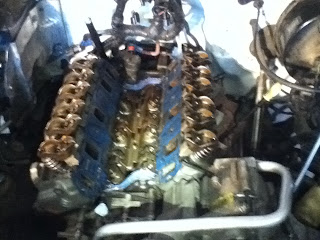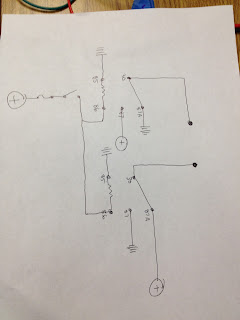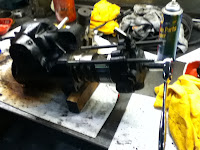





By far the most important thing that I've learned over this engine section of the quarter is how important cleanliness is while working. Worked on the 16 cylinder cat engine set up at school. Got the head off, piston pulled, and liner removed and spent a good deal of time cleaning.

I hooked up the Modis to my pickup because it was idling high, and then when the engine speed dropped the engine felt like it was misfiring quite a bit. Also have quite a high pitched noise that goes away, or at least diminishes significantly, with throttle applied. KOER tests showed misfire counts progressively going up at around 2 per second. The long term fuel trim (LTFT) reading on bank 2 was reading a value of 10 during low idle, and would drop to around 3 with throttle. short term fuel trim (STFT) readings were good for both banks, at close to 1. The values for bank 1 LTFT were also close to 1 consistently.
"LTFT Adaptation Valve Positive (+) LTFT>1: A) Lack of fuel or too much air, ECU is attempting to increase the amount of fuel by increasing the injector open time and/or B) could be caused by unmetered air leaking past the EVAP, EGR, or into the air intake system after the Air Mass Meter (MAF) or a fuel pump delivery problem or clogged or damaged fuel injector."
Set up a compression test for cyliners 1-6 respectively (psi): 183, 171, 171, 175, 180, 177. I seem to remember that alldata has information stating that I should really be concerned if I have a low range of around 125 if my highest reading is 175. Spark plug gaps should be 0.042-0.044 in, ended up being: 0.054, 0.056, 0.054, 0.050, 0.075, 0.054. Plugs on cylinders 2,3, and 5 had heavy amounts of wet oil and cylinder 5 had a large amount of caked on... gunk (?). Picked up another gasket set and head bolts and set about doing the job right.
I scrubbed away at the vibration damper to find the ever elusive timing marks. From there, I took a page from something Raul told me about and I measured around the circumference (18 in), then divided by 3 to get marks every 120*. Knowing the firing order, I know which piston is at TDC for each mark. I spent an easy 12 hours cleaning and chasing threads over the weekend, as well as found that at least 2 of my valve stem seals were torn or the compression spring had failed. Both rubber gaskets between the lower intake manifold and block were shredded as well as both gaskets between lower intake manifold and cylinder head were torn. I attribute those rapid failures to my lack of preparation and cleanliness of mating surfaces. I am also hoping that the valve train noise under load, as mentioned in previous posts, will be resolved. I figure that because I did not chase the rocker arm fulcrum bolt holes my torque values are not even close to accurate, which could, from what I'm thinking, cause the rockers to be looser than tolerance. I'm hoping.


Hours for last 2 weeks: 56
Total Hours: 315






































